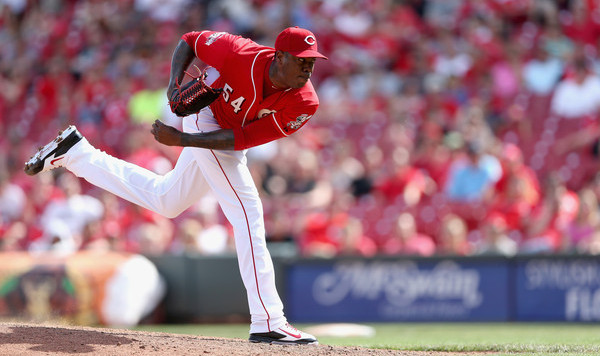
Whenever you think about Aroldis Chapman, your mind immediately jumps to his fastball. And for good reason. He’s the hardest thrower in baseball history and there’s just something super exciting about seeing that 100 on the scoreboard. It’s still special, even with velocity at an all-time high around the league.
There’s much more to Chapman than velocity readings though. He’s got an interesting backstory — he was the first of the recent wave of huge money Cuban players — and he does in fact have other pitches besides the fastball. It’s easy to understand why everyone talks about the velocity, but there is more to Chapman than that. Much more.
The Stride
Last season Chapman’s fastball averaged 100.4 mph. Averaged. He topped out at 104.5 mph according to PitchFX. And, believe it or not, his fastball actually plays faster because of his long stride. Chapman is listed at 6-foot-4, and his stride is among the longest in the game, so he releases the ball closer to the plate than most pitchers. Check out this video from 2012:
Also, Chapman is gaining velocity. Most guys who throw 100 mph do it very early in their careers, and it’s gone by time they reach 24 or 25 years old. Even relievers. A triple-digit fastball doesn’t last long-term, historically. That is not the case with Chapman. He’s throwing harder now than he did two, three, four years ago. I mean, look:
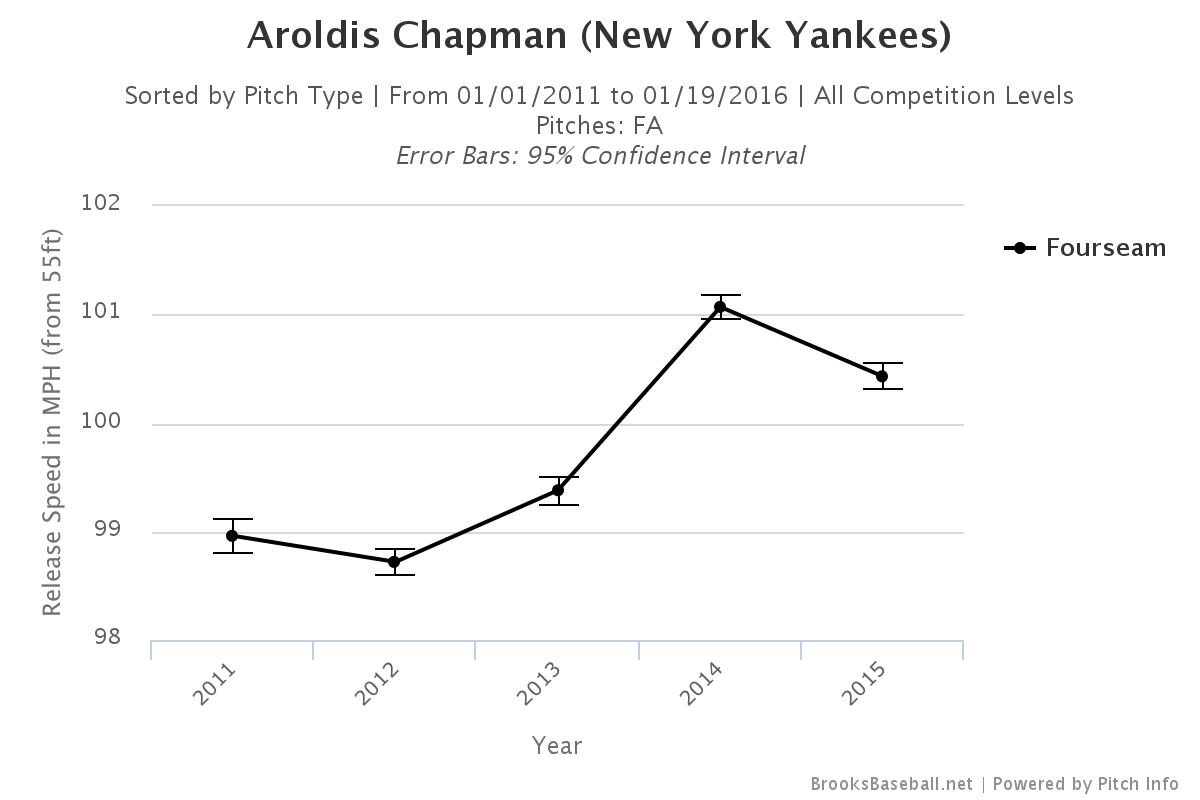 I laughed. I saw that graph and I literally laughed out loud. The term freak of nature is so overused these days, so when you come across an actual freak of nature like Chapman, it doesn’t have the same meaning. That sucks. This guy does things no other human has ever done. It’s not normal. And he’s going to do it in pinstripes next year.
I laughed. I saw that graph and I literally laughed out loud. The term freak of nature is so overused these days, so when you come across an actual freak of nature like Chapman, it doesn’t have the same meaning. That sucks. This guy does things no other human has ever done. It’s not normal. And he’s going to do it in pinstripes next year.
The Slider
Believe it or not, Chapman does indeed have pitches other than his fastball. He also throws a slider with pedestrian velocity relatively to his fastball — the slider averaged 87.6 mph last summer. That’s a pretty significant velocity separation, which leads to swings like this:
The hitter gets geared up for that triple-digit fastball — which plays up because of his stride! — and then the pitch makes a right turn when it gets halfway to the plate. When hitters swung at Chapman’s slider last season, they missed 51.2% of the time. Hitters were more likely to come up empty than make contact against the slidepiece. Insanity.
The Changeup
A fastball and a slider is plenty for most relievers, especially if they throw as hard as Chapman. That didn’t stop him from adding a changeup, however. Chapman relied on his fastball/slider combo up until the 2014 season, when he gradually began to mix in some changeups. He’s gotten more and more comfortable with the pitch and now throws it about 8% of the time. Not much, but enough that hitters have to respect it.
As you’d expect, Chapman uses the changeup primarily against righties. He goes after lefties with the fastball/slider and righties with the fastball/changeup. This is the movement Chapman is able to get on his changeup, which averages 88.7 mph:
The hitter gears up for the fastball because they have no choice but to gear up for the fastball, but then the changeup drops off the table. Hitters missed with 56.8% of their swings against the changeup last season. As far as third pitches go, that’s as good as it gets.
The Pitch Mix
When you throw 100 mph all the time, I have to imagine the temptation is rather high to throw nothing but fastballs. And you know what? Chapman did throw almost nothing but fastballs earlier in his career. He threw the heater 87.7% of the time back in 2012. Over the last few seasons Chapman has begun to rely a little more on his slider and changeup:
Chapman is still throwing his fastball three out of every four pitches, so it’s not like he’s abandoning the pitch, but he is breaking out the slider and changeup a little more often. The result is a bit more efficiency and substantially more weak contact. Chapman set a career-low in pitches per plate appearance last season (4.21), and his soft contact rate was by far his best in years:
Striking everyone out is super cool, and Chapman still racks up an incredible amount of strike ’em outs, but now he’s getting some more weak contact and more quick outs with the slider and change. That’s a good thing for him personally. Think of it as self-preservation. The fewer high-stress pitches, the better. The Yankees only figure to have Chapman for one year, so they aren’t too concerned about his career long-term, as callous as that sounds.
Chapman is not a one-trick pony. He’s always going to be known as the guy with the best fastball in history, but there’s more to him than that. Chapman’s fastball plays faster because of the stride, he also has a slider, and in recent years he added a changeup as well. He’s not as much of a thrower as people seem to think. Chapman’s become a much more well-rounded pitcher the last few years.
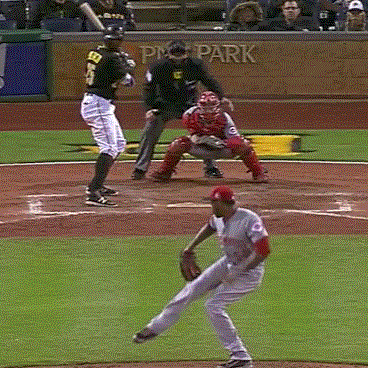
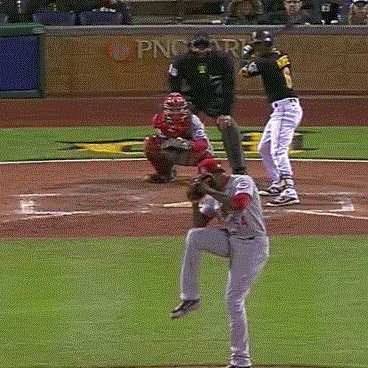
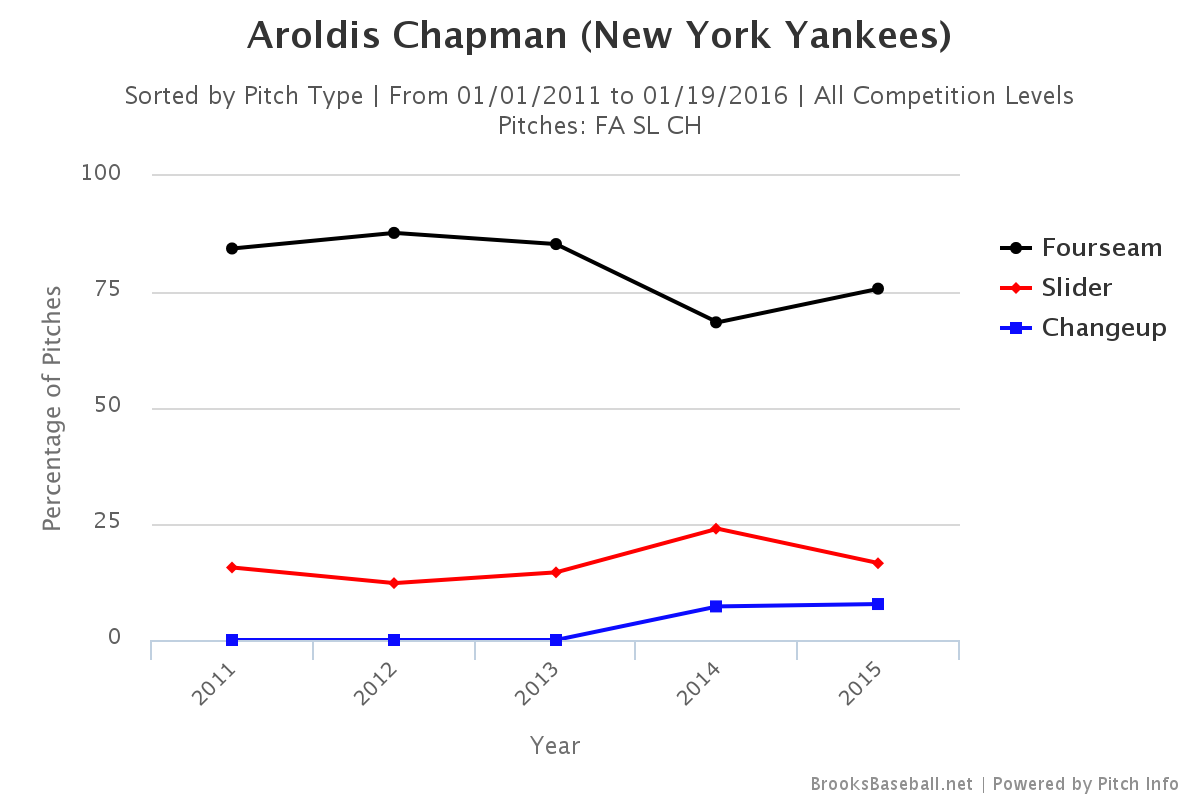
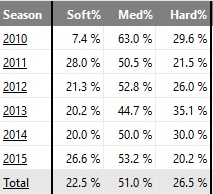
Leave a Reply
You must be logged in to post a comment.